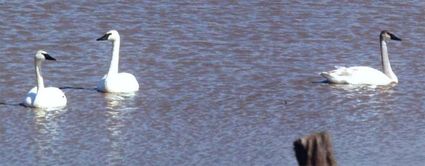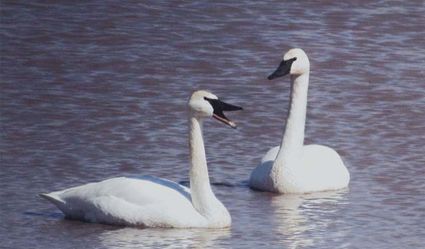Swans seen on Ruskin pond
March 18, 2021

Orlyn Renz, Ruskin, snapped this photograph of trumpeter swans swimming on a pond owned by Mark Eggers. Trumpeter swans are a rare sight in this area. They are the largest of the water fowl birds in North America, with a wing span which can measure up to nearly 80 inches. The birds are entirely white with black bills and legs. They eat aquatic vegetation and forage in agriculture fields. Immature birds are grayish brown.
With thousands of snow geese passing through this area during the annual fall and spring migration, it isn't unusual to see white birds this time of year. Occasionally we have had whooping cranes stop at Lovewell. Pelicans are regular visitors but few people see the occasional Trumpeter Swans.
Orlyn Renz, a rural resident living northeast of Hardy, is among the few who have seen the occasional visitors in this area.
Earlier this month, Renz snapped these pictures of what appeared to be a family group on Mark Eggers' pond in East Central Nuckolls County. Based upon their size, two appeared to be adults. One was smaller, perhaps not as old as the larger companions. Science tells us swans mate for life and often travel in small family groups.
While not unheard of in this area, this area is off the path travelled by most migrating swans. However, last year Renz photographed a group of eight. He wonders if there is a connection between the groups.
The Trumpeter Swan is named for its sonorous calls, which are often compared to the sounds of a French horn. It is the largest waterfowl species native to North America, reaching up to 35 pounds in weight and is one of the heaviest flying birds in the world.

Orlyn Renz, Ruskin, snapped this photograph of trumpeter swans swimming on a pond owned by Mark Eggers. Trumpeter swans are a rare sight in this area. They are the largest of the water fowl birds in North America, with a wing span which can measure up to nearly 80 inches. The birds are entirely white with black bills and legs. They eat aquatic vegetation and forage in agriculture fields. Immature birds are grayish brown.
The Trumpeter once bred widely across North America. By the early 20th century the Trumpeter had declined to near-extinction. Numbers have since rebounded some. American Bird Conservancy reported in 2015 the Trumpeter Swan population included about 34,000 individuals.
Three swan species can be found in North America. The native Trumpeter and Tundra Swans and the non-native Mute Swan. The latter is native to Europe and Asia and often out-competes native swans for habitat and food.
The Trumpeter Swan is sensitive to human disturbance and pollution. The species does best in clear, quiet waters that provide invertebrates and aquatic plants for food. It matures late, not nesting until four to five years of age and forms life-long pair ponds. Young swans may pick nesting sites a year or more in advance of the first use. In the wild, the average life span is 12 though some are known to live as long as 30 years.
The swans cover their eggs with the enormous webbed feet to keep their eggs warm. Both parents care for the young.
Young swans remain with the parents learning traditional migration routes and winter spots.











Reader Comments(0)